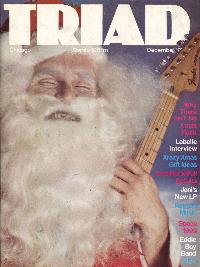Criticism
Bob Bassi

Triad (the magazine of radio station WXFM106 in Chicago, Illinois), December 1975
It's lonely at the top.
It's also dumb. How else to explain the decision of the major television networks to turn down Space: 1999? The series' producer, Independent Television Corporation, first offered this classy program to ABC, CBS, and NBC. Space: 1999 had everything: Big Name Stars; some Even Bigger-Name guest stars (Margaret Leighton, Peter Cushing, Christopher Lee); an incredible budget of $275 000 per episode; the most sophisticated gadgetry and spectacular special effects ever seen on television; and a ready-made audience, built around hard-core Star Trek fans.
When offered an obvious hit, the network decision makers merely yawned. But what the networks refused, the usually hard-pressed independent stations seized upon joyfully. The rest is television history.
Space: 1999 is now syndicated in 100 countries besides the United States, where it is shown on 155 stations. The results are impressive: in Chicago, Space: 1999 recently took 35 per cent of the TV audience, outrunning The Wonderful World of Disney, pro football, and even the world series. The show did equally well in New York and Los Angeles.
The series itself is almost as impressive as the records it has set. In the year 1999 the nations of the earth have established Moonbase Alpha, manned by an international crew of 311. Since the climate of the moon is too barren, even for Howard Miller to sell retirement ranchettes, earth's once-romantic satellite is also being used, as a dumping ground for radioactive wastes. When this material suddenly reaches critical mass, a series of spectacular thermonuclear explosions blows the moon out of the earth's orbit and into space. Moonbase Alpha remains intact; its crew has no choice but to go along for the unexpectedly epic ride.
Leading the misbegotten for whom the moon is now home are the Base Commander John Koenig and his chief medical officer (Martin Landau and Barbara Bain, the husband-and-wife team of the old Mission: Impossible series) and the base's head scientist Professor Victor Bergman (Barry Morse, the implacable Lt. Gerard of the now placable series, The Fugitive). Their job: to find a planet which they can orbit and call home.
The picaresque journey is an old but still valid idea Indeed, in Star Trek the U.S.S. Enterprise each week travelled from one heavenly body to another in search of adventure. But the new series is more than Star Trek with elbow room.
Star Trek laid heavy emphasis on character, particularly the complex relationships between Captain Kirk, Mr. Spock, and Dr. McCoy. This placed a heavier burden on the show's stars as actors. To date, Space: 1999 has shown little indication of going this route. [Non science fiction fans may be surprised to learn of Star Trek's "complex" relationships, but it at least had recognizable characters, a rarity in 1960s science fiction.] The cast on the whole look uncomfortable in their roles. While Martin Landau has begun to refine the character Commander Koenig a bit, Barbara Bain looks like 45 rpm being played on 33. She seems to prefer slow monotones and soulful gazes to acting. Barry Morse, an excellent actor, seems to be having the same problems. He somnambulates through the scripts as though he's still exhausted from chasing the fugitive. Moreover, for a science officer, he's remarkably unscientific.'
Strong scripts would probably make such problems less noticeable, but one is surprised by some curious lapses. On one planet where the average temperature 40 degrees, the characters romp through ice and snow in Rudy Gernreich-designed costumes which look better suited to the Sahara. [The ski suits in Death's Other Dominion were real ski suits, and were not designed by Gernreich. The temperature is quoted as being between -60 and -189 degrees.]
In "Collision Course" Moonbase Alpha destroys giant meteor which was on a head-on path for the moon, only to suddenly notice that behind the asteroid, undetected by all their instruments, is an entire planet. Even the show's basic premise contains a flaw: the moon blast could not possibly provide sufficient speed to get the moon where it's supposed to be week after week.
If this seems like nit-picking, please remember that half of science fiction is science. Thus it is indeed a bother when, week after week, large chunks of the plot have to be taken on faith. [This is a "flaw" that Space: 1999 shares with 2001 and Star Wars.]
To distract viewers from pondering such question Brian Johnson and Nick Allder, special effects designer and director, provide a visual treat so delightful that Space: 1999 may be the only show on television which can be appreciated with the sound turned off. Johnson as many will recall, was responsible for the special effects in 2001: A Space Odyssey. Enough said.
Above all, please don't consider this a negative view of Space: 1999. All of these problems can be corrected. Whether the show's producers do so or not is another question. As the moonbase's computer would put it: "Human decision required." Moreover, for science fiction fans, it and Star Trek reruns are the only game in town. As the actors get inside their roles-and the script writers inside the show's concept the flaws and kinks may work themselves out.
So for now bless WGN-TV for imagination. Bless Space: 1999 for being there. May they live long and prosper.
Space: 1999 copyright ITV Studios Global Entertainment